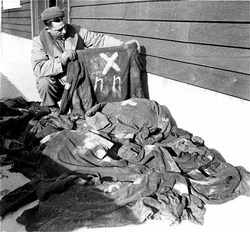The Concentration Camp System
The Concentration Camp System
Definition of a Concentration camp
According to German Law, a concentration camp (Abbrev KZ) was a place where people were interned, i.e., detention centres, if they had not been legally sentenced to a term of imprisonment by the country’s court system, or for those individuals whom the Sicherheitsdienst (SD - which was the Nazis secret intelligence agency, i.e., its Security Service), or the Geheime Staatspolizei (Gestapo - which was the state’s Secret Police) or even the Geheime Feldpolizei (Secret Field Police) wanted locked up. This detention was called Schutzhaft (protective Custody), and this obviously meant that anyone could simply disappear into the camp system without even having committed a crime, in fact, lots of people who were legally imprisoned by a German court were arrested by the Gestapo, Police or the Field Police on their release from lawful custody and then taken straight to a concentration camp and held there indefinitely. Only those who interned these people had any idea how long their incarceration would last. Thes incarcerations are labelled preventive Police custody.
Germany’s ‘Criminal Police’ force (Kriminalpolizei also known as Kripo), can apply to have individuals placed within the concentration camp system if they know them to be either a habitual criminal or drunkard. Drunkards (alcoholics) are placed in custody to protect themselves from themselves and habitual criminals are placed in the camps to protect the public, therefore, it is deemed protective custody. And Jews are simply put into the camps because they are Jews. From 1940, the Kripo also had the power to send juveniles to be interned within a Jugend Schutzhaftlager (Youth Protective Custody Camp). Boys aged between the ages of 16-21 would be sent to the camp at ‘Moringen’ near Göttingen, whereas the girls aged 16-19 would be sent to ‘Uckermark’ concentration camp, which was part of the Ravensbrück conentraion camp system from 1942 onwards.
The KZ System Was primarily controlled and administered by the SS-Wirthschafts und Verwaltungshauptamp (SS Economic and Administrative Headquarters - WVHA) and the Reichssicherheitshauptamt (SS Reich Security Main Office – RSHA) which were overseen by the Heinrich Himmler himself.
The Camp Personnel were generally made up of members of the SS-Totenkopf Sturmbann (Skull Brigades).
Grading KZ Prisoners
Prisoners were graded by the Reichsführer-SS [Heinrich Himmler] as stated within a document dated September 1940.
Stufe 1 (Level 1) was aimed at anyone under light sentences or those deemed reformable, also those who were placed in solitary confinement or other special cases. They should be placed within Dachau or Sachsenhausen.
Stufe 2 (Level 2) was aimed at anyone who had limited work abilities, but still can still be used as labour within say vegetable gardens. These prisoners should be sent to either Buchenwald, Flossenbürg or Dachau.
Stufe 3 (level 3) was earmarked for those classed as being under heavier sentences as habitual criminals, anti-socials (work-shy and Gypsies) and those who it is believed cannot be reformed.
Two other Levels were later added: ‘Nacht und Nebel häftlinge’ (Night and Fog Prisoners), these prisoners were made up of resistance activists and those who helped them, as well as political activists, who were simply regarded as enemies of the state. The purpose of the Nacht and Nebel policy was for these prisoners to simply disappear into the system and die there without anyone knowing outside the camp knowing where they were or what happened to them. The other level was for ‘Facharbeiter’ (skilled workers).
This grading system that Himmler had implemented became impactable as the war progressed and prisoners were moved one camp to another, it really all depended on where they were needed the most.
Nacht und Nebel Inmates (NN)
According to the Nact und Nebel decree, which was ordered by Hitler, was turned into practise on the 7th December 1941 when it was signed by Field Marshal Wilhelm Keitel. This decree, stated that those prisoners who were not by definition ‘German’ and who had been arrested for creating unrest, either at home or within German occupied countries; or if they attacked members of a German armed forces, with the aim to kill or maim them, or engaged in any sabotage activities, or assisting the enemy in any way, or being involved in Communist agitation, or if they were caught in possession of illegal firearms, were all to be subject to execution. If the execution can be achieved within seven days, then they have to disposed of where they are, if more time was need, they were to be transferred to concentration camp under as an ‘NN’ prisoner, so that they could be executed at a later date.
